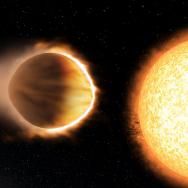When people think about the most important ingredient for life on other planets, they usually talk about water. But there’s another element that makes our existence possible.
“We’re carbon-based life forms,” said University of Chicago geophysical scientist Fred Ciesla, “and carbon is an important part of keeping a mild climate.”
It can also be used as forensic tool to piece together how the earth and solar system must have formed. In two papers, Ciesla and colleagues at California Institute of Technology, the University of Michigan and the University of Minnesota laid out a history of carbon in the formation of the solar system.
By examining carbon, the scientists found that a large fraction of the Earth's building blocks probably formed soon after the solar system did—within the first million years, much earlier and more precise than the previous estimate of sometime within the first 150 million years. This discovery may also inform the search for life elsewhere in the galaxy.
The devil in the details
Even within our home system, questions still surround the formation of the Earth and our sibling planets. The prevailing theory is that the solar system began as a giant cloud of hot gas and dust that coalesced into the sun; then, gradually, pieces started to clump together into planets as the whole thing cooled down.
But the planetary devils are in the details. Each element behaves differently based on the conditions it was experiencing at the time, so scientists can examine today’s molecules to find clues about what that environment was like back then—similar to how a footprint looks different if it’s made in soft mud after a rain, versus after a dry spell. This back-tracing has been done extensively for other elements, but less so for carbon.
By tracing the history of carbon this way, the team found a gap in the theory.
One of the papers, led by Jie (Jackie) Li of the University of Michigan, estimated the total amount of carbon that could possibly be contained within the Earth. The research found that, relatively speaking, the planet has just a little bit of carbon. While this amount of carbon is just right for life on Earth—enough to trap some heat from the sun, but not so much that the heat bakes the planet like it does on Venus—this Goldilocks amount of carbon is difficult to explain under the existing theory, which better accounts for either no carbon or a lot of carbon.
That’s because once carbon carrier molecules have been vaporized, they only re-form into solids that could get sucked up by the baby Earth when temperatures are very, very cold (in the neighborhood of -350 degrees Fahrenheit). And that doesn’t work because early on, it was hot in here.
“We’d expect to see much higher temperatures around where the Earth formed,” Ciesla said—so it’s extremely unlikely any carbon would be available nearby to get vacuumed up.
Instead, the team came up with an ingenious alternate explanation for the just-right amount of carbon. They started with astronomical observations of other solar systems that suggest at least half of the carbon floating around in the initial cloud of gas and dust probably took the form of organic molecules that stay solid up to very high temperatures—about 440 degrees Fahrenheit—before turning to gas.
This provides a template for the scenario: Initially, Earth began forming at much higher temperatures, so most of its building blocks formed without any carbon available. But as the solar system cooled toward the end of the process, the temperatures around the young Earth dropped below 440 degrees, allowing a small amount of the later-added pieces to contain pristine, never-vaporized organic carbon carrier molecules. This, the researchers said, can get you to that “Goldilocks” amount of solid carbon.
This research slots a significant chunk of Earth’s formation into a very specific window of time, during which the temperatures ranged from above 440 degrees to just below. From other evidence, this period appears likely to have happened within the first million years or so of the solar system’s existence—a much narrower window than the 150 million years that scientists had already estimated based on when the final piece was added to the planet.
“Planetary formation used to be thought of as a protracted process, where it takes millions of years to assemble building blocks that then take tens of millions of years to come together, but this evidence makes it look considerably faster than that,” said Ciesla, a professor and chair of UChicago’s Department of Geophysical Sciences. This finding, he added, also fits with telescopic observations of other star systems that are just forming their own planets.
Carbon copies
The picture is backed up by analysis of meteorites. For scientists, meteorites are like little floating snapshots of various points in time and space as the solar system formed. The team looked closely at a set of iron-rich meteorites that are thought to have formed in the same million-year time frame as the young Earth did in their theory. These don’t have very much carbon. Previously, scientists had explained this away by saying that these meteorites started out with lots of carbon, but then lost it as they heated up.
But the team back-calculated how much carbon there was to begin with when the meteorite originally formed, and found that even though the meteorites had lost some carbon by heating, that wasn’t quite enough to explain all of it. “The original building blocks must have been carbon-poor, just like the Earth’s were,” Ciesla said.
How planets acquire carbon probably also affects other elements important to life, like nitrogen and hydrogen, the scientists said, and a complete understanding will help us point our telescopes in the right directions to find habitable exoplanets.
“By advancing our understanding of how planets form, we can identify those conditions that are most likely to give rise to habitable planets,” said Ciesla. “We can use this to inform future observations of exoplanets by telling observers where to invest their precious, limited telescope resources.”
Ciesla also said that this research, which tells a story spanning time and space, was only possible with the combined expertise of scientists from multiple fields—from geochemists rigorously measuring the tiniest fractions of isotopes inside meteorites and terrestrial samples, to astronomers observing the movements of gigantic clouds in the furthest reaches of the galaxy.
“It’s a challenging but very stimulating way to work, because everyone thinks so differently,” he said.
In addition to Li, the co-authors on the papers were University of Michigan astronomer Edwin Bergin, Geoffrey Blake of Caltech and Marc Hirschmann of the University of Minnesota.
Citations:
“Early volatile depletion on planetesimals inferred from C-S systematics of iron meteorite parent bodies.” Hirschmann et al, Proceedings of the National Academy of Sciences, March 30, 2021.
“Earth's carbon deficit caused by early loss through irreversible sublimation.” Li et al, Science Advances, April 2, 2021.

